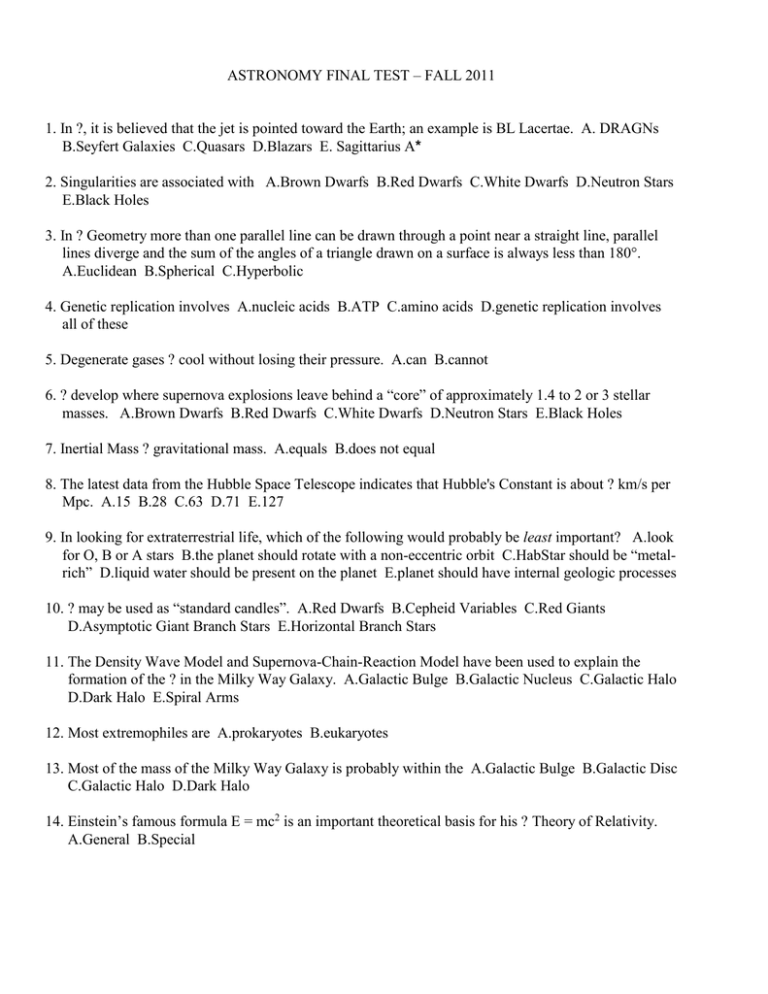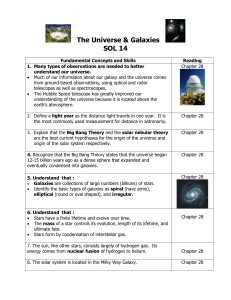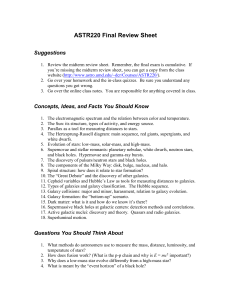Document 17773032
advertisement

ASTRONOMY FINAL TEST – FALL 2011 1. In ?, it is believed that the jet is pointed toward the Earth; an example is BL Lacertae. A. DRAGNs B.Seyfert Galaxies C.Quasars D.Blazars E. Sagittarius A* 2. Singularities are associated with A.Brown Dwarfs B.Red Dwarfs C.White Dwarfs D.Neutron Stars E.Black Holes 3. In ? Geometry more than one parallel line can be drawn through a point near a straight line, parallel lines diverge and the sum of the angles of a triangle drawn on a surface is always less than 180°. A.Euclidean B.Spherical C.Hyperbolic 4. Genetic replication involves A.nucleic acids B.ATP C.amino acids D.genetic replication involves all of these 5. Degenerate gases ? cool without losing their pressure. A.can B.cannot 6. ? develop where supernova explosions leave behind a “core” of approximately 1.4 to 2 or 3 stellar masses. A.Brown Dwarfs B.Red Dwarfs C.White Dwarfs D.Neutron Stars E.Black Holes 7. Inertial Mass ? gravitational mass. A.equals B.does not equal 8. The latest data from the Hubble Space Telescope indicates that Hubble's Constant is about ? km/s per Mpc. A.15 B.28 C.63 D.71 E.127 9. In looking for extraterrestrial life, which of the following would probably be least important? A.look for O, B or A stars B.the planet should rotate with a non-eccentric orbit C.HabStar should be “metalrich” D.liquid water should be present on the planet E.planet should have internal geologic processes 10. ? may be used as “standard candles”. A.Red Dwarfs B.Cepheid Variables C.Red Giants D.Asymptotic Giant Branch Stars E.Horizontal Branch Stars 11. The Density Wave Model and Supernova-Chain-Reaction Model have been used to explain the formation of the ? in the Milky Way Galaxy. A.Galactic Bulge B.Galactic Nucleus C.Galactic Halo D.Dark Halo E.Spiral Arms 12. Most extremophiles are A.prokaryotes B.eukaryotes 13. Most of the mass of the Milky Way Galaxy is probably within the A.Galactic Bulge B.Galactic Disc C.Galactic Halo D.Dark Halo 14. Einstein’s famous formula E = mc2 is an important theoretical basis for his ? Theory of Relativity. A.General B.Special 15. Almost all stars in the Milky Way will “end up” as A.Brown Dwarfs B.Pulsars C.White Dwarfs D.Neutron Stars E.Black Holes 16. Which of the following is not true concerning Olbers’ Paradox? A.the night sky should be bright rather than dark B.Doppler Shifts means that starlight has “stretched” to non-visible wavelengths C.the Universe is so large that much of the starlight has not reached us D.the Universe is static and infinite 17. During the Radiation Era A.the Universe was too hot for atoms to be stable B.the Universe had cooled enough where atoms could be stable 18. ? Geometry is “closed” geometry. A.Euclidean B.Spherical C.Hyperbolic D.all of these are “closed” geometries 19. Which of the following astronomical bodies would be least likely to have/had life forms? A.Enceladus B.Europa C.Titan D.Mars E.Io 20. ? develop where a normal star transfers mass to its White Dwarf companion; the white dwarf may produce an explosion each time enough new matter has accumulated. A.Novas B.Type Ia Supernovas C.Type II Supernovas D.Neutron Stars E.Pulsars 21. Starburst galaxies were ? in the early universe. A.rare B.common 22. The Big Crunch would occur if the geometry of the Universe was A.Euclidean B.Spherical C.Hyperbolic D.all of these geometries may end in the Big Crunch 23. A sugar-cubed size lump of ? on Earth would weigh about 100 million tons. A.Brown Dwarf B.Red Dwarf C.White Dwarf D.Neutron Star E.Black Hole 24. The Universe “looks the same in every direction”, and therefore the same physical laws apply everywhere. This defines the concept of A.homogeneity B.isotropy C.this defines all of the above 25. Massive stars have ? lifetimes than less massive stars. A.shorter B.longer 26. Probably ? Red Dwarfs have “left the Main Sequence”. A.no B.few C.many D.all 27. Which of the following is an “active galaxy”? A. DRAGN B.Seyfert Galaxy C.Quasar D.Blazar E.all of these are “active galaxies” 28. The Local Group includes A.the Milky Way B.Large Magellanic Cloud C.Andromeda Galaxy D.Triangulum Galaxy E.the Local Group includes all of the above 29. The ? Theory states that as the multiverse expands some regions stop stretching and form bubble-like structures, which have different Symmetry Breaking. A.Level I Multiverse B.Level II Multiverse C.Level III Multiverse D.Membrane (M-Theory) 30. HII Regions consist of ? A.Emission Nebula B.Absorption Nebula C.Reflection Nebula D.Diffuse Interstellar Dust E.Diffuse Interstellar Gas 31. CETI primarily utilizes A.x-rays B.gamma-rays C.radio waves D.visible light E.infrared radiation 32. The Great Attractor seems to be “pulling” the Milky Way toward the constellation A.Orion B.Hercules C.Leo D.Virgo E.Centaurus 33. If the observed cosmological density is greater than the critical density, the geometry of the universe is A.Euclidean B.Spherical C.Hyperbolic D.it could be any (or all) of these geometries 34. The Milky Way is in the ? Supercluster. A.Orion B.Hercules C.Leo D.Virgo E.Centaurus 35. The most massive element that can form in a star’s core during “regular” nuclear processes is A.carbon B.nitrogen C.oxygen D.silicon E.iron 36. The Universe is dominated by A.Regular/Ordinary Matter B.Dark Matter C.Dark Energy D.all of these are equally important 37. The best theory for the formation of galaxy clusters seems to be the ? Model. A.Pancake B.Turbulence/Primordial Vorticity C.Hierarchical Clustering 38. ? consist of enormous, cool stars with helium-burning shells. A.Red Dwarfs B.Yellow Giants C.Red Giants D.Asymptotic Giant Branch Stars E.Horizontal Branch Stars 39. The creation of matter from radiation is termed A.Baryogenesis B.Annihilation C.Pair Production D.Cosmic Inflation E.Decoupling 40. ? was proposed in order to resolve the Horizon, Flatness and Structure Problems. A.Baryogenesis B.Annihilation C.Pair Production D.Cosmic Inflation E.Decoupling 41. Spectral redshifts are ? in galaxies “close” to us versus those that are far away. A.smaller B.larger C.the spectral redshifts are the same 42. The production of Quark-Gluon Plasma (“Quark Soup”) occurred immediately ? Cosmic Inflation. A.before B.after 43. ? lack organelles and have no membrane-bound nucleus; they reproduce asexually. A.eukaryotes B.prokaryotes 44. ? Theory is based on String Theory. A.Level I Multiverse B.Level II Multiverse C.Level III Multiverse D.Membrane (M-Theory) 45. The Magellanic Clouds are typically classified as ? galaxies. A.Dwarf Elliptical B.Giant Elliptical C.Normal Spiral D.Barred Spiral E.Irregular 46. Which of the following is true? A.baryons form quarks and gluons B.quarks and gluons form baryons C.both of these may be true 47. The most widely accepted theory for the cause of Cosmic Inflation is A.Baryogenesis B.Annihilation C.Pair Production D.Phase Change E.Decoupling 48. In the production of ?, the rate of transfer to the White Dwarf is high; eventually the mass of the White Dwarf increases so that its core becomes dense and hot enough for the almost instantaneous burning of carbon and other elements to take place. A.Novas B.Type Ia Supernovas C.Type II Supernovas D.Neutron Stars E.Pulsars 49. The “clearing” of the Universe occurred when most of the ions and electrons in the Universe combined to form atoms. This is termed A.Baryogenesis B.Annihilation C.Pair Production D.Cosmic Inflation E.Decoupling 50. ? are very powerful luminous and very distant galaxies with large redshifts. A. DRAGNs B.Seyfert Galaxies C.Quasars D.Blazars E.all of these are luminous, very distant galaxies with large redshifts 51. Most of the stars in the Milky Way are probably A.Brown Dwarfs B.Red Dwarfs C.White Dwarfs D.Neutron Stars E.Black Holes 52. Gravitational redshifts and time dilation would be most associated with A.Brown Dwarfs B.Red Dwarfs C.White Dwarfs D.Neutron Stars E.Black Holes 53. In general, Galaxy Clusters are ? than Galaxy Groups. A.smaller B.larger C.this refers to the same grouping of galaxies 54. ? build proteins A.nucleic acids B.ATP C.amino acids D.all of these build proteins 55. The “galactic year” ? from the center of the Milky Way Galaxy to the outer edge. A.decreases B.increases C.the “galactic year” is the same throughout the Milky Way Galaxy 56. White Dwarfs represent the “cores” of A.Red Dwarfs B.Yellow Giants C.Red Giants D.Asymptotic Giant Branch Stars E.Horizontal Branch Stars 57. Our Sun will end its life as a A.Brown Dwarf B.Red Dwarf C.White Dwarf D.Neutron Star E.Black Hole 58. Einstein’s ? Theory of Relativity is his theory of gravity. A.General B.Special 59. ? is composed of both Population I and Population II stars; it is warped due to the gravitational influence of local galaxies. A.Galactic Bulge B.Galactic Disc C.Galactic Halo D.Dark Halo 60. Millisecond Pulsars are probably due to the presence of A.Black Holes B.X-Ray Bursters D.Type Ia Supernovas D.binary companion stars E.Type II Supernovas 61. Einstein's Principle of Equivalence is the fundamental idea of his ? Theory of Relativity. A.General B.Special 62. ? spiral galaxies are “barred”. A.few B.most 63. Organic molecules are ?-based. A.nitrogen B.oxygen C.hydrogen D.helium E.carbon 64. Sagittarius A* is in the A.Galactic Nucleus B.Galactic Disc C.Galactic Halo D.Dark Halo 65. Stars ? massive than our Sun fuse hydrogen by means of the Carbon (CNO) Cycle. A.less B.more 66. The Algol Paradox concerns the A.development of Black Holes B.formation of White Dwarfs C.evolution of binary star systems D.formation of X-Ray Bursters E.formation of Pulsars 67. The Hubble Classification System defines A.star formation B.galaxy shapes C.star death D.Quasar formation E.cosmological models 68. Einstein's explanation of ? is that matter causes curvature of spacetime. A.mass B.energy C.gravity D.all of these are explained by Einstein’s theories 69. There ? center to the Universe. A.is a B.is no 70. Temperature and luminosity of a star changes ? while it is on the Main Sequence. A.little B.a lot 71. ? Galaxies have very little gas and dust between the stars and contain few if any young stars. A.Spiral B.Elliptical C.Irregular 72. “Symmetry Breaking” concerns the A.time interval before the Big Bang occurred B.the moment of Cosmic Inflation C.sequence of events in the Big Rip D.sequence of events in the Big Crunch E.formation of fundamental particles 73. ? Stars are “metal-rich” young stars. A.Population I B.Population II C.both Population I and Population II stars are “metal-rich” young stars 74. The reason that matter dominates in our Universe (rather than antimatter) has been defined as A.Baryogenesis B.Annihilation C.Pair Production D.Cosmic Inflation E.Decoupling 75. In forming ?, the object shrinks to zero radius and the density and gravity become infinite. A.Brown Dwarfs B.Red Dwarfs C.White Dwarfs D.Neutron Stars E.Black Holes 76. The Milky Way Galaxy is probably an ? Galaxy. A.Dwarf Elliptical B.Giant Elliptical C.Irregular D.Normal Spiral E.Barred Spiral 77. Dark Energy is ? the expansion of the Universe. A.slowing B.accelerating 78. It is believed that the Sagittarius Dwarf Elliptical Galaxy collided with the A.Andromeda Galaxy B.Triangulum Galaxy C.Milky Way Galaxy D.Small Magellanic Cloud E.Large Magellanic Cloud 79. The “Strong Force” A.consists of photons B.represents the decay of elementary particles C.binds particles together in the atomic nucleus D.consists of gravity E.all of these form the “Strong Force” 80. Active Galactic Nuclei are associated with A.CNO Cycles B.SMBHs C.triple alpha processes D.Galactic Groups E.Galactic Clusters 81. Most interstellar gas consists of A.“metals” B.helium C.hydrogen D.these elements occur in equal amounts in interstellar space 82. Pulsars are probably rotating A. Brown Dwarfs B.Red Dwarfs C.White Dwarfs D.Neutron Stars E.Black Holes 83. The Galactic Halo is made of ? stars. A.Population I B.Population II C.the Galactic Halo is made of both Population I and Population II stars 84. The Virgo and Coma Clusters are ? clusters. A.poor B.rich 85. When a star’s opacity is ?, radiation flows easily out of the star. A.low B.high 86. The Miller-Urey Experiment produced A.nucleic acids B.ATP C.amino acids D.carbon-based lifeforms 87. Planetary nebulae form at the end of the ? stage of star formation. A.Red Dwarf B.Yellow Giant C.Red Giant D.Asymptotic Giant Branch Star E.Horizontal Branch Star 88. The “Instability Strip” of the H-R Diagram contains A.Red Dwarfs B.Yellow Giants C.Red Giants D.Asymptotic Giant Branch Stars E.Horizontal Branch Stars 89. A star’s Roche Lobe is the region A.where Red Giants form B.where Red Supergiants form C.where its gravity dominates D.where Black Holes form E.where Quasars develop 90. ? Galaxies contain a few million solar masses and average about 2,000 parsecs across; they may have formed by coalescing primordial globs of gas, etc. or could have been formed by the gravitational disruption of other galaxies. A.Dwarf Elliptical B.Giant Elliptical C.Normal Spiral D.Barred Spiral E.Irregular 91. ? often appear blue. A.Emission Nebula B.Absorption Nebula C.Reflection Nebula D.Diffuse Interstellar Dust E.Diffuse Interstellar Gas 92. During the ? stage of star formation, the hydrogen -depleted core becomes hot enough to ignite the fusion of hydrogen into helium in a thin shell. A.Red Dwarf B.Yellow Giant C.Red Giant D.Asymptotic Giant Branch E.Horizontal Branch Stars 93. The latest estimate for the age of the Universe is about ? billion years. A.4.567 B.8.25 C.10.71 D.13.75 E.28 94. This is Test “A”. Please answer “A” for Question # 94.



